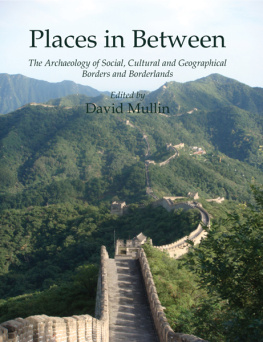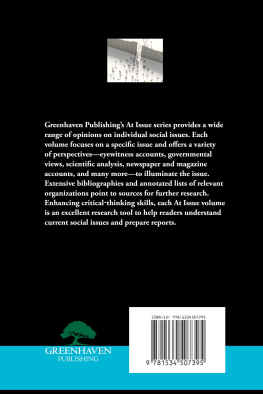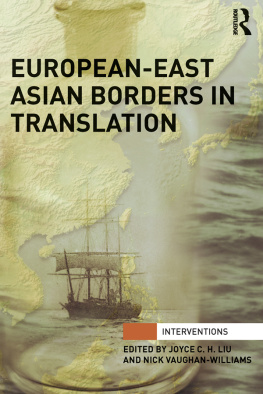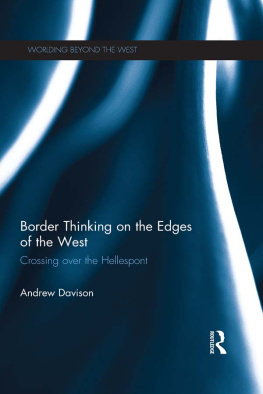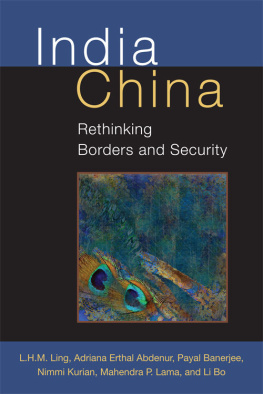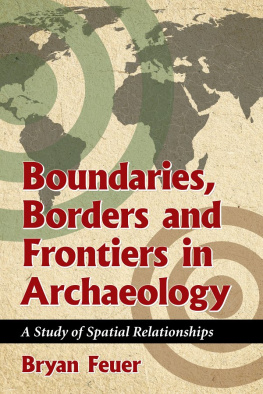
Published by
Oxbow Books, Oxford, UK
Oxbow Books and the authors, 2011
PRINT ISBN 978-1-84217-983-3
PDF ISBN: 9781842175934
EPUB ISBN: 9781842175910
PRC ISBN: 9781842175927
A CIP record for this book is available from the British Library
This book is available direct from:
Oxbow Books, Oxford, UK
(Phone: 01865-241249; Fax: 01865-794449)
and
The David Brown Book Company
PO Box 511, Oakville, CT 06779, USA
(Phone: 860-945-9329; Fax: 860-945-9468)
or from our website
www.oxbowbooks.com
Cover image:
The cover photograph shows the construction of the new Border Wall between Mexico and the United States
at Hidalgo, Texas. It was photographed by Efran Salinas Salinas who kindly agreed to allow its use.
More of his photographs are available here: http://pasaraza.blogspot.com/
Efran Salinas Salinas.
ALL RIGHTS RESERVED
Library of Congress Cataloging-in-Publication Data
Places in between : the archaeology of social, cultural and geographical borders and borderlands / edited by David Mullin.
p. cm.
Includes bibliographical references.
ISBN 978-1-84217-983-3
1. Borderlands. 2. Social archaeology. 3. Archaeology and history. I. Mullin, David.
CC72.4.P53 2011
930.1--dc22
2011010650
Printed in Great Britain by
Hobbs the Printers
Totton, Hampshire
Contributors
DAVID MULLIN
Department of Archaeology
University of Reading | JODIE LEWIS
Institute of Science and the Environment
University of Worcester |
ANNA MCWILLIAMS
The Centre for Baltic and East European Studies
Sdertrns hgskola
Flemingsberg, Sweden | ANNE MONIKANDER
Department of Archaeology and Classical Studies
University of Stockholm, Sweden |
JAIME JENNINGS
Bioarchaeology Research Group
Department of Archaeology
University of Durham | ISOBEL PINDER
Department of Archaeology
University of Southampton |
ELISE FRASER
Department of Archaeology
University of Reading | NAOMI STANDEN
School of Historical Studies
Newcastle University |
RICHARD BRADLEY
Department of Archaeology
University of Reading | GWEN BENNETT
Departments of Anthropology and East Asian Studies
McGill University, Quebec, Canada |
Border Crossings
The Archaeology of Borders and Borderlands
An introduction
David Mullin
I drink to Wales!
Gabriel roars: And I to England! and stands,
facing the other across the table.
Gwen purses her lips.
I give the border she says, very quietly.
Margiad Evans The Country Dance (1932)
The concept of the border as a metaphor has been widely exploited across the Arts and Humanities, indeed, an entire body of Border Theory (Michaelsen and Johnson 1997) has been developed, critiqued and rethought (Welchman 1996). It is remarkable, therefore, that this body of theory, and the exploitation of the border as a rhetorical and heuristic device, has largely been ignored by archaeologists, who have instead preferred to examine social and cultural boundaries, frontiers, marginality and ethnicity. It is one of the aims of this book to explore some of the possibilities offered by the study of borders from an archaeological point of view and present some new perspectives informed by border theory.
The study of borders has historically been the realm of geographers (both political and physical) with particular interest paid to international boundaries between nation states. Prescott (1965) summarised the concerns of political geographers in relation to the border landscape and the investigation of political boundaries has become increasingly relevant since the fall of the Berlin Wall, war in the Balkans and the reconfiguration of eastern Europe. Donnan and Wilson (1999, 157) have suggested that the continuing study of international boundaries will further contribute to the understanding of international power relationships, politics and policy. Recent approaches to border studies are summarised in a number of articles and books by authors including Donnan and Wilson (2001), Kolossov (2005), Newman (2006), Rumford (2006) and Welchman (1996). The discipline has its own journal: The Journal of Borderlands Studies whilst the May 2006 issue of the European Journal of Social Theory also took borders as its theme. There is a Centre for Border Studies at the University of Glamorgan; Centres for Borders Research at Queens University, Belfast and Radboud University, Nijmegen, Netherlands; a Department of Border Region Studies at the University of Southern Denmark; a Centre for Law and Border Studies at the University of Texas and a Centre for Latin American and Border Studies at the University of New Mexico. The Association for Borderland Studies organises an annual conference, an International Borders Conference was held in 2006 and the Cleveland State University, Ohio has organised a series of symposia with borders as a theme (Medina-Rivera and Orendi 2007).
Whilst this demonstrates the continuing and sustained study of political and geographical boundaries, the concept of the borderland has expanded to include nearly every psychic or geographical space about which one can thematize problems of boundary or limit (Johnson and Michaelson 1997, 12) or, more simply, any place where differences come together (Price 2004, 8). These approaches have frequently referred to the classic work Borderlands/La Frontera by Gloria Anzaldua, where the metaphorical qualities of borders and borderlands are explored: the ways in which borderlands can be simultaneously physical, psychological, sexual, racial and class-based are described and the border between the US and Mexico seen as forming the location where two worlds [merge] to form a third country a border culture (Anzaldua 1987, 3). Indeed, the ability of those living in border regions to access different kinds of discourse which span different ethnicities, communities and nationalities has led to borderlands being described as at once both dangerous and festive (Lavie 1992, 93) and as representing socially charged places where innovative cultural constructs are created and transformed (Lightfoot and Martinez 1995). Scholars in a number of fields have gone on to explore the rich metaphorical qualities of borders and focus has centred on questions of delineation, division and identity; what it means to border other peoples, cultures and ideas and the analysis of the process of bordering: the interaction of inclusive and exclusive practices which distinguish distinct communities (Ackleson 2004, 324).
One of the central themes of border studies has been inter- and trans-disciplinarity (Newman 2006; Brunet-Jailly 2005): the breaking down of borders between institutions, disciplines and approaches in order to better study border phenomena. Archaeology has, so far, unfortunately contributed little to recent studies.
Archaeologists have long been concerned with boundaries and frontiers, but this could be seen as the product of a paradigm rooted in culture-history and concerned with the identification of bounded, homogenous cultural units. The identification of such units has historically been deeply implicated with the legitimisation of national interests and identity through archaeological enquiry. Through the early 20th century, archaeologists such as Kossina and Childe formalised these approaches, the former intrinsically linked with the rise of German National Socialism and the identification of a superior culture linked to an ethnic group which coincided with modern Germany. Kossina (cited in ) developed the concept of an archaeological culture as representing clearly recognisable people or tribes, claiming that it was possible to identify groups such as the Germans and Celts and their territories in the archaeological record. Childe (1935, 1989), went on to define culture in terms of the prevalence of common traditions, institutions and way of life which result in distinctive distributions of material remains. Cultural assemblages related to peoples or folk, but culture and race did not necessarily coincide. For Childe, cultural innovation was constrained by tradition: ways of doing things learnt in childhood were kept in place by cognitive and social norms and thus bounded, homogenous cultural entities were constructed that corresponded to particular peoples, ethnic groups, races or tribes. Culture was perceived as prescriptive and made up of sets of shared beliefs and ideas, maintained by regular interaction and transmitted via socialisation. The result was a continuous and cumulative cultural tradition where change is only possible by particularly innovative groups who were either naturally more creative or advantaged in their environment or biology. Diffusion was thus the key to the explanation of cultural change and the archaeological project was seen as the mapping and describing cultural histories.
Next page
